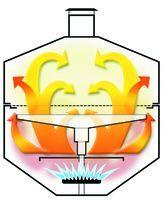Originally Posted by Mike McDonald
as for the smoker controller the one i suggested is 1200 watt max. Didnt realize the brinkman element was 1500 watt. Would I need a more powerful smoker controller?
what do you think?
thank you
Mike
I did not pull up the full specs for the controller the first time. Just figured it was one of their PID's and would be running a SSR relay like most electric cabinet builds and did not see it was a ready to run setup.
Yes, that one is not going to run the Brinkmann element, however they do have one that will. This one is rated at 1,800 watts and also has dual temp displays (food and pit temp). It's a little more expensive though.
http://www.auberins.com/index.php?main_page=product_info&cPath=14_28&products_id=203
I would try and find a 1/4" or 3/8" flat steel plate to use as both a heat shield and heat sink (try what you have on hand first, it might work and you can always stack more than one piece for extra mass if needed). I would think putting the element in the center of the bottom of the main chamber and then having this thick steel plate over the element would do two things. The mass of the steel would tend to moderate temperature swings and the plate would also absorb heat from the element, buffering it across the entire surface of the plate as it is radiated upwards. The tuning plates work the same way depending on how you set them up. The goal is an even temperature across the entire cooking chamber. If you heat that flat plate from beneath it will tend to radiate the heat fairly evenly upwards, although you would get slight convection spillage of heated air around the edges of the plate. Adding mass will add to the warm up time before a smoke, but once you run it and figure out it takes x minutes to get to operating temps, that should be pretty consistent for the start of each cook. Not sure how your pit is set up with the plates, but I would put some sort of standoff rack above the plate and use that to sit disposable drip pans. If you set aluminum drip pans directly on the heated plate it will tend to want to burn the grease drippings and change your heat radiation profile as well. Just a cheap cookie rack on top of the plate to give some air circulation space between them should be fine.
Since you have tuning plates material already, the $30 investment of the Brinkmann element would let you plug it into a 12 gauge extension cord and see if the tuning plates you have can be adjusted to accomplish even heating. You might could even stack them on top of each other for more mass directly over the heating element. You may not need to buy another plate, but the only way to find out is to try it. Check grate temps at several locations and adjust the plates to get even heating. Once you have that figured out (and assuming it will reach at least 225*), you just need to add the higher amperage controller.
I'm pretty certain the electric element will give a better (more even) heat radiation profile in the main cooking chamber bottom than in the side fire box, but that might work. If it does, I would think your tuning plates would work like they do using fire as the heat source, but would probably need to be adjusted for the lower overall temp of the heated air that would be entering the main chamber from the SFB.
If the element alone running 100% of the time with no controller will not hit 225* either way, then you either have to insulate the cooking chamber or get a bigger element (anything over 1,500 watts and you are moving into 220v range and special wiring of outlets).
I don't know if you have ever seen a Holland Grill, but that is sort of the effect I'm talking about. I used to have one of those and it has a single large round gas burner in the bottom of the cook chamber. There is a 3/8" thick square steel plate directly over the burner. It gets red hot (there is only one gas setting and it's "ON"). This plate then radiates the heat upwards and acts like a buffer. There is another pan mounted above that to catch the drippings that is separated from the steel plate by an air gap (exactly like I'm talking about here). It basically makes a gas powered convection oven. We are talking about the same thing here but using an electric element for the heat source. You may not need as thick of a plate as you can control the electric element with the PID.
Here is a cut-a-way image of how the Holland Grill works to help give you an idea of what I'm talking about. This image is looking from one side through the grill and out the other. There is a grease drain pipe (like in a reverse flow SFB smoker) on one side but in this image it looks to go through the burner (it does not).
Here is an image of the flat iron plate over the burner (with catch pan and grate removed)
And the catch pan that drains to a pipe on the right (pan slopes downward) with the grate removed. I do not think you would need this size catch pan and a simple stand off grate (cookie cooling rack) above your heat dispersal plate (tuning plates) would likely hold drip pans and work just fine. Their design uses a built in drip pan that drains out the right side like a reverse flow stick burner would.
And the grate added.













